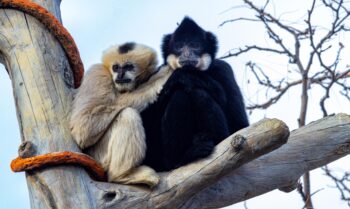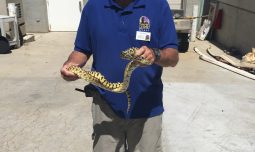July 22, 2019
Rick’s Rolling Out
Honoring One of Denver Zoo’s Longest-Serving—and Now Retiring—Animal Care Team Members
By Lindsey Kirkman, Assistant Curator of Pachyderms
National Zookeeper Week is a chance to recognize those that are responsible for the wellbeing of more than 800,000 animals in AZA-accredited zoos and aquariums, and pay tribute to individuals who have elevated the profession. Rick Haeffner, who recently retired from Denver Zoo after 40 years, is one of those individuals. He’s played a significant role in shaping the Zoo into what it is today, and witnessed the evolution of the Zoo—and zoo industry—throughout the course of his four decades in animal care. I had the chance to talk to Rick about his long, illustrious career, and what he considers his biggest accomplishments before he retired early this month.
How did you get your start at Denver Zoo?
I started keeping tropical fish when I was in 5th grade. When I graduated college and bought a house, I filled the unfinished basement with terrariums and fish tanks. I had about 70 fish tanks and 200 reptiles, and was working at the largest fish store in Colorado. One of my customers suggested I apply here and I did. Then the Zoo decided to build Tropical Discovery and it was just the right time, right place for me. It was one of those lucky life things.
How would you describe your job as Curator of Tropical Discovery?
As a curator, my primary job is to manage the various species we have in Tropical Discovery, including acquisition, disposition and all aspects of their care, ranging from husbandry to consulting on their medical care. I also manage everything that supports the animals, including our keeper staff and the facilities. Maintaining the building and life support systems are a huge part of the job.
What do you love about working with reptiles, amphibians and fish?
Getting a species in that is new to my experience and working with the keeper staff to sort out the best husbandry and, if applicable, the reproduction of that species. That’s one of the really cool things about being a keeper or a manager of reptiles, amphibians, and fish—you get experience with so many different species!
So, you must have cared for a LOT of different animals during your time here.
Yes, and not only in Tropical Discovery. I’ve also been a Bird Keeper, Assistant Curator, General Curator and Area Supervisor for Carnivores and Hoofstock. Tropical Discovery has hovered between 280 and 370 species at any given time and it has been open for 26 years. When I was a Bird Keeper, my section included 65 or 70 bird species at a time.
So, it’s probably around 600 different species.
What’s your biggest accomplishment at the Zoo?
Tropical Discovery is my pride and joy, and it’s been a thrill to see it become a guest favorite—85 percent of guests come through TD during their visit! I was involved in everything from helping our planning team design a portion of the building to determining what reptile, amphibian and fish species we would take care of. Later, I pushed for the addition of a Komodo dragon wing, which is still open today and one of the best-known parts of the building. It’s amazing to see how that work has paid off and how much guests enjoy coming to TD!
You’ve also had a role in saving some lives. Can you tell me more about that?
Denver Zoo holds antivenom for all our venomous snake species, unless it’s a species where no antivenom exists. It expires after two to six years, and costs between $25,000 and $40,000 a year to maintain. But we don’t just keep it for ourselves. Like most zoos, we put our inventory of antivenom in a database with emergency contact information in the event someone is bitten by a venomous snake. We have sent out antivenom five times since Tropical Discovery opened, most recently for an 8-year-old boy that was bitten by a friend’s monocled cobra in Phoenix. We were the closest zoo that had the antivenom. A series of helicopter rides got it to Phoenix and saved the boy’s life. His symptoms reversed within an hour.
What’s the biggest change you’ve seen in the Zoo in your 40 years?
When I started, there were only about 80 total employees across all departments, including 22 zookeepers, who worked in every area of the Zoo. Your schedule could be birds one day and primates the next. It kept you on your toes and made you a jack of all trades. Today, we have more than 400 employees, including 124 animal keepers, managers, veterinarians and vet techs, doing everything from education and programming to fundraising and media!
Finally, what are you going to miss most about the Zoo and this job?
The people and the relationships that I’ve built with them. I’ve known some of the people here for more than 25 years. But right up there with the people are the animals. I enjoy managing our amazing group of animals in Tropical Discovery. I’ve been lucky enough to help make decisions about which fish and reptiles to take care of here, which is a unique position to be in. And I’ve been very lucky to have a job that is always changing because of the nature of taking care of animals.
Subscribe
Be among the first to hear the latest animal updates, important stories and details about all the fun happening around Denver Zoo.
Tags
-
 April 15, 2024
April 15, 2024Good Luck, Chuck!
Good Luck, Chuck! Beloved Bachelor Relocating as Part of Asian Elephant Species Survival Plan In a heartfelt and collaborative…
-
 April 15, 2024
April 15, 2024African Impact
African Impact Two New African Field Conservation ProgramsAim to Protect Gorillas + Grey Crowned Cranes We're honored to provide…
-
 March 1, 2024
March 1, 2024Last Place(s) on Earth
Last Place(s) on Earth New Asian Field Conservation Programs Protect Asian Elephants, Sumatran Orangutans + more Indonesia's Leuser Ecosystem…


